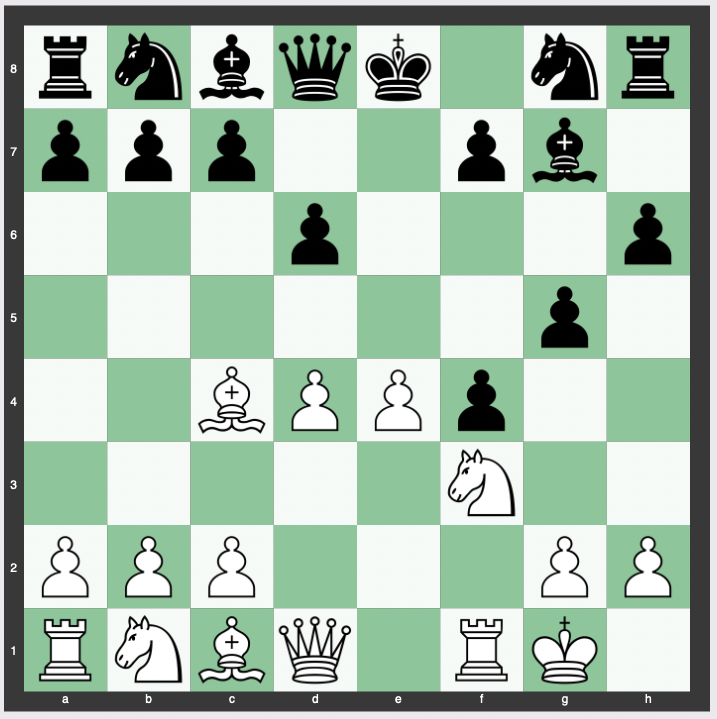The Hanstein Gambit is a dynamic, aggressive opening for white in the game of chess.
Often derived from the King’s Gambit, this particular gambit opens up a world of complex lines and unique positional characteristics that often force the player to walk a tightrope of opportunities and threats.
The Hanstein Gambit and Its Origins
The Hanstein Gambit, named after the 19th-century German chess player Otto von Hanstein, is a notable opening strategy in the game of chess.
Otto von Hanstein was known for his innovative strategies, and this gambit exemplifies his approach to the game.
Move Order of the Hanstein Gambit
The Hanstein Gambit follows the moves:
1. e4 e5 2. f4 exf4 3. Nf3 g5 4. Bc4 Bg7 5. d4 d6 6. O-O h6

After the first few common moves of the King’s Gambit, white diverges with 4.Bc4, and black responds with 4…Bg7.
This diverging move, 4.Bc4 Bg7, sets the stage for the Hanstein Gambit.
The Main Line of the Hanstein Gambit
After the opening moves have set the scene, the Hanstein Gambit proceeds with 5.d4 d6 6.0-0 h6.
At this stage, the gambit unfolds in full, with white solidifying their center and preparing to castle, while black seeks to solidify their kingside position.
White’s aim in the Hanstein Gambit is to establish a strong center with the move 5.d4. This move is often followed by castling on the kingside with 6.0-0.
Black, in the meantime, focuses on reinforcing their position with 5…d6 and 6…h6, slowing white’s aggressive advancement while also safeguarding their own king.
Hanstein Gambit vs. Philidor Gambit
It’s crucial to note the difference between the Hanstein Gambit and the Philidor Gambit, as they are often mentioned in the same breath due to their common origin from the King’s Gambit.
The Philidor Gambit arises with the moves 1.e4 e5 2.f4 exf4 3.Nf3 g5 4.Bc4 Bg7 5.h4 h6 6.d4 d6
While it bears some similarities with the Hanstein Gambit, the major distinguishing factor lies in the earlier commitment to 4.h4 in the Philidor Gambit.
While both gambits involve a quick development of pieces and an aim for quick attack, the differences in pawn structure and piece activity make for two distinct middlegame plans.
Evaluation of the Hanstein Gambit
The Hanstein Gambit is generally evaluated at around -1.30 to -1.40 for white.
Common responses to Hanstein’s Gambit are:
- 7. Nc3
- 7. c3
- 7. h4
Continuation lines of the Hanstein Gambit include:
7. Nc3
7. Nc3 Nc6 8. Nd5 Nge7 9. c3 Nxd5 10. Bxd5 Qf6 11. Qe2 Qg6 12. Bd2 Bd7 13. a4 O-O-O 14. a5 Ne7 15. Bb3 Rde8 16. e5
7. Nc3 Nc6 8. Nd5 Nce7 9. Nxe7 Nxe7 10. c3 O-O 11. g3 d5 12. exd5 fxg3 13. hxg3 Nxd5 14. Qd3 Qd6 15. Rf2 c5 16. Bd2 Be6
7. Nc3 Nc6 8. Nd5 Nce7 9. Nxe7 Nxe7 10. c3 O-O 11. h4 d5 12. exd5 Nf5 13. hxg5 hxg5 14. Nxg5 Qxg5 15. Bxf4 Qh4 16. Qe1 Qxe1 17. Raxe1 Nd6 18. Bd3 Bd7
7. c3
7. c3 Nc6 8. h4 Qe7 9. a4 Bd7 10. b4 Nf6 11. e5 Nxe5 12. dxe5 dxe5 13. Ba3 Ng4 14. b5 Qf6 15. Bc5 O-O-O 16. Bxa7 e4
7. h4
7. h4 Nc6 8. c3 Nge7 9. Qb3 O-O 10. hxg5 Na5 11. Qa4 Nxc4 12. Qxc4 hxg5 13. Nxg5 Ng6 14. Nf3 Qe7 15. Nbd2 Be6 16. Qd3 Rae8 17. b3
Conclusion
The Hanstein Gambit, steeped in the traditions of aggressive chess play, offers a feast for players who enjoy complex situations, dynamic positions, and tactical fireworks.
It provides a fascinating example of the flexibility of the game, and its propensity for innovation and creativity.
While it’s certainly not for the faint-hearted, the Hanstein Gambit, when played well, can lead to a beautiful and decisive victory in the royal game.


